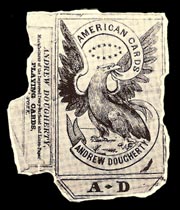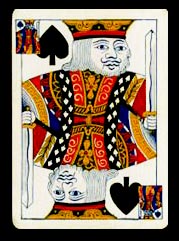
|
| « History of Playing Cards | Early Standards | Gallery of Playing Cards | Card Games Rules | CONTACT |
Andrew Dougherty
Playing Cards, History, America 19th Century
Andrew Dougherty, the American Card Company, began making playing cards in 1842. His workshop in Brooklyn, New York, has never been described as sophisticated, and hence the workmanship which came out of it was regarded, at least in the early days, as rather crude even by 19th Century standards.

The playing cards he made were branded “American Cards” and were characterized by the familiar Eagle emblazoned on the wrappers. By 1858 he was expanding his enterprise into new premises and churning out ever more cards onto the market which would establish him as one of the big players in American playing card history.
During the Civil War, he issued an edition of American Cards that were decorated with the Union’s stars and stripes. This was said to be in rebuke to his English counterparts, Goodall of London, who had issued playing cards draped with the Confederate flag. Around this time he also manufactured his famous “Army and Navy Cards” (1865).
But perhaps his greatest triumph came with his edition of “Illuminated Great Moguls” (1865). These playing cards were gold embossed and would really establish his workmanship as comparable to that of the venerable American card master, Lewis I. Cohen.
In 1872 Dougherty established a new manufactory in Center Street, New York, and from there manufactured some of the earliest examples of double-ended playing cards, replete with rounded corners – an innovation he never failed to advertise. The earliest examples, however, were still published without corner side indices. But it was his rivalry with the New York Consolidated Card Company which would usher in this new innovation so that by the mid 1870’s corner side indices were coming into standard production.

The earliest examples being produced by Dougherty were called “Triplicate Cards” (1875). These were playing cards with “miniatures” in diametrically opposed corners. This allowed players to hold their cards in a tight fan and still be able to identify what they had. At the same time, the New York Consolidated Card Company was manufacturing a similar innovation which they called “Squeezers”. A tacit understanding of the sales territory between the two rivals is commemorated in a card back of 1877, showing two bulldogs straining at their leashes – one collar says “Squeezer” and the other “Trip”.
In 1896 Andrew Dougherty retired from business and transferred the ownership of his holdings to his three sons who continued to publish all the Dougherty brands.
L I N K S
Andrew Dougherty 1848-1930 - World of Playing Cards
Playing Cards from U.S.A. - World of Playing Cards
The Work of Andrew Dougherty
Card Masters of the |
||||||||
| Thomas de la Rue | ||||||||
| Lewis I. Cohen | ||||||||
| Lawrence & Cohen | ||||||||
| Samuel Hart | ||||||||
| Andrew Dougherty | ||||||||
| Ferdinand Piatnik | ||||||||
| ||||||||
|
||||||||
| ||||||||
|